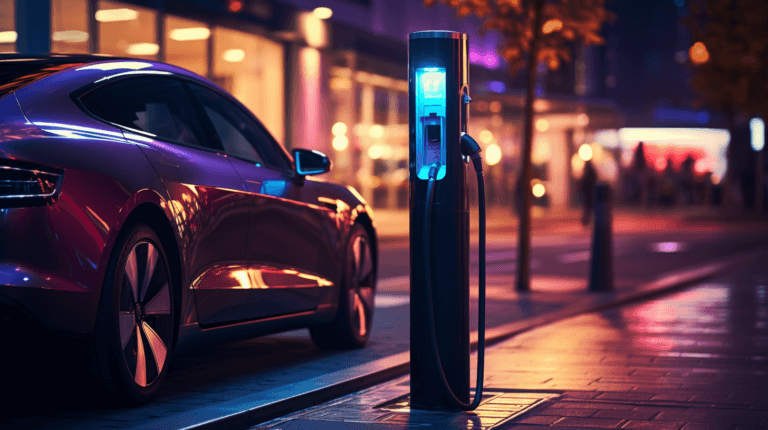Dynamic Load Balancing for EV Chargers Explained
Global electric car sales surged to nearly 14 million in 2023, accounting for 18% of all cars sold worldwide.
That’s up 35% on the previous year.
This explosive growth has propelled the global electric fleet to 40.5 million vehicles, with EV adoption set to continue accelerating, according to industry analysts.
Enter dynamic load balancing—a game-changing technology for EV charging systems.
Unlike static load balancing, which relies on predetermined power allocation, dynamic systems continuously monitor and adjust power distribution based on current demand and grid conditions.
For EV charging infrastructure providers and fleet managers, understanding and implementing dynamic load balancing is key to tackling the complexities of modern EV charging. This innovative approach not only significantly reduces charging costs and improves efficiency but also ensures your infrastructure is future-proof and ready to meet the demands of tomorrow’s electric mobility landscape.
Whether you’re managing a small fleet or overseeing a large-scale charging network, mastering dynamic load balancing is key to staying ahead in this fast-moving industry.
What is Dynamic Load Balancing for Electric Vehicle Charging?
Dynamic load balancing is an advanced energy management technique that optimises power distribution across multiple EV chargers in real-time.
Unlike static load balancing, which uses predetermined power allocation, dynamic systems continuously monitor and adjust power distribution based on current demand and available capacity.
How Dynamic Load Balancing Works in EV Charging
At its core, this system continuously monitors power consumption at each connected charging point, and the power coming into the site.
This constant vigilance allows the system to maintain an up-to-the-minute understanding of the overall charging landscape.

Using this real-time data, the dynamic load balancing system employs intelligent algorithms to allocate power efficiently. It considers factors such as the number of vehicles charging, their individual battery levels, and the total available power capacity.
This intelligent power allocation ensures that each vehicle receives the optimal amount of energy without overloading the site or compromising the charging speed of other connected EVs.
Adaptable Technology for Power Management
One of the key strengths of dynamic load balancing is its ability to adapt swiftly to changing conditions. As vehicles connect or disconnect from charging points, or as their charging needs evolve during a session, the system automatically readjusts power distribution.
This adaptive approach maximises the use of available power and minimises waiting times for EV drivers. Dynamic load balancing also plays a crucial role in preventing site overloads.
By implementing power limitations when necessary, it maintains grid stability and protects the electrical infrastructure from potential damage due to excessive demand.
Energy consumption of EV charging vs common household appliances
Appliance/Device | Power (kW) | Daily Use (hrs) | Daily Energy (kWh) |
|---|---|---|---|
EV Charger (L2) | 7.2 | 4 | 28.8 |
Electric Oven | 2.3 | 1 | 2.3 |
Refrigerator | 0.15 | 24 | 3.6 |
Air Conditioner | 3.5 | 8 | 28 |
Washing Machine | o.5 | 1 | 0.5 |
LED TV | 0.1 | 4 | 0.4 |
Desktop Computer | 0.2 | 8 | 1.6 |
Note: These values are approximate and may vary based on specific models and usage patterns.

This proactive management ensures a reliable and consistent charging experience for all users while safeguarding the longevity of the charging infrastructure.
Benefits of Dynamic Load Balancing for EV Charging
- Maximise Infrastructure Use: Dynamic load balancing allows more efficient use of existing electrical infrastructure, reducing the need for costly upgrades.
- Increased Charging Capacity: By optimising power distribution, more EVs can be charged simultaneously without overloading the system.
- Enhanced User Experience: Drivers benefit from faster charging times and reduced service interruptions.
- Grid Stability: The risk of overloads and potential blackouts is minimised, ensuring a more reliable charging network.
- Future-Proof Scalability: As EV adoption grows, dynamic load-balancing systems can easily adapt to increasing demand.
LinkRay: Advanced Dynamic Load Balancing Solution
Versinetic’s LinkRay module is at the forefront of dynamic load-balancing technology for EV charging.
Here are just some of the ways LinkRay leverages DLM (Dynamic Load Management) to optimise charging efficiency:
- Real-time Power Monitoring: LinkRay continuously monitors power consumption across all connected charging points and the site meter, providing up-to-the-second data on energy usage.
- Intelligent Power Distribution: Using advanced algorithms, LinkRay dynamically allocates available power among connected EVs, ensuring optimal charging rates for each vehicle without exceeding site capacity.
- Adaptive Load Management: As vehicles connect or disconnect, or as their charging needs change, LinkRay swiftly readjusts power distribution to maintain optimal efficiency.
- Predictive Demand Analysis: LinkRay analyses historical charging data and patterns to anticipate future demand, allowing for proactive load balancing decisions.
- Grid Stability Protection: By implementing power limitations when necessary, LinkRay helps to prevent overloads and maintains grid stability, ensuring reliable charging for all connected vehicles.
Local vs Cloud-Based Dynamic Load Balancing
While both local and cloud-based dynamic load balancing solutions offer benefits, each has its unique advantages:
Local Dynamic Load Balancing:
- Faster response times
- Operates without internet connectivity
- Enhanced data privacy
Cloud-Based Dynamic Load Balancing:
- Centralised management of multiple locations
- Easy scalability
- Advanced analytics and reporting capabilities
LinkRay offers the best of both worlds, providing robust local load balancing with the option for cloud integration when needed.
Summary
Dynamic load balancing is transforming EV charging infrastructure, offering significant benefits in efficiency, capacity, and user experience.
As the EV market continues to grow, solutions such as LinkRay will play a significant role in ensuring our charging networks can meet the increasing demand while maintaining grid stability.
Looking to optimise your EV charging infrastructure with advanced dynamic load balancing?
Further reading

Dunstan is the founder of EV charger design consultancy, Versinetic. He is a chartered electronics engineer who has been providing design, production support and consultancy to businesses around the world for over 30 years. Dunstan graduated from Cambridge University with a degree in electronics engineering in 1992. After working in the industry for several years, he co-founded multi-award-winning electronics engineering consultancy ByteSnap Design in 2008. He then went on to launch international EV charging design consultancy Versinetic during the 2020 global lockdown. An experienced conference speaker domestically and internationally, Dunstan covers several areas of EV charger design and electronics product development, including load balancing, V2G, IoT, integrated software design and complex project management.
In his spare time, Dunstan enjoys hiking and astronomy.



